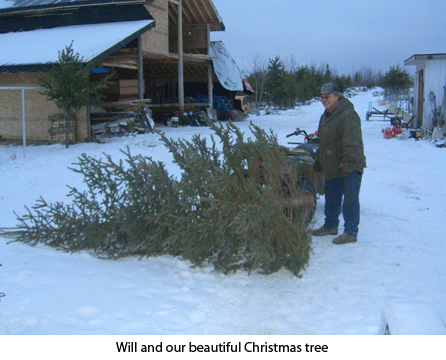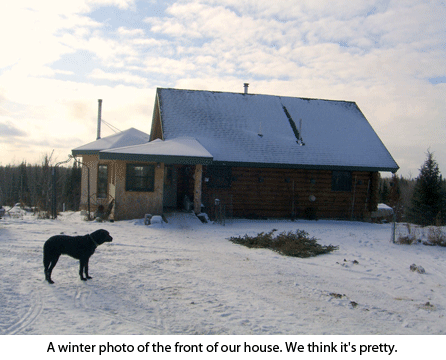Last week, just when things were gearing up for Christmas, my gut felt ishy. Then all heck broke loose. You get the picture. David had the same thing, which he brought home from school a month ago. So when I should have been baking and packing cookies and goodies, I lay on the couch where the bathroom was REAL close. This went on for nearly five days! Not fun! I was so sick that Will felt sorry for me and went out into the woods and cut our Christmas tree to cheer me up. It worked. And the next day I did feel better. And I’m finally over it, but boy what a bug this one was! Whew.
We put the beautiful tall spruce up in the new living room yesterday to warm up and hopefully, tomorrow evening, we will decorate it. In the meantime, I’m writing Christmas cards like mad trying to catch up.
Readers’ Questions:
Root cellar in hot and humid area
I live in the prairie lands in one of the SW states, Texas. I plan to retire soon and will have plenty of time for gardening. I enjoy gardening and putting up the harvest. I was wondering if root cellaring in this part of the country is one practical method of storing my harvest. I am not sure if the right temperatures can be achieved in a hot and humid state most of the year. What do you think?
Kenneth Whitmire
Aledo, Texas
If you have the room, a root cellar is a good thing, no matter where you live, PROVIDED that your water table is not too high. We lived on the high prairie, in NE New Mexico. The old lady who had homesteaded on our place had a much-used root cellar. While a root cellar in the south won’t be as cool as one in the north, it will definitely help you keep your fruits and vegetables longer than if they were just kept in the warm house. By leaving the floor dirt or gravel, and maintaining humidity, this helps keep most produce even longer. A root cellar is also a good thing when you are in tornado or hurricane prone areas too, for family preservation. And you have plenty of food available right at your fingertips!
Keep your cellar well insulated, with closing vents, to keep out the very hot summer temperatures. I don’t think you’ll be disappointed with your cellar. — Jackie
Hopi Pale Grey squash seeds
Jackie, not really a question but information, Baker Creek Heirloom Seeds have Hopi Pale Grey squash seeds on their seed list…I can’t explain just how many hours of pleasure the magazine and your blog have given me. Wonderful treat to find the magazine in my mailbox during the rainy season.
Joan Orr
Lopez Island, Washington
Yes, I’ve seen that they have the Hopi Pale Grey seeds on their online catalog. I looked because it wasn’t listed again this year in their print catalog and I freaked out! JUST when someone was starting to carry it again. Thanks for the kind words. — Jackie
Tough chicken
My wife, Evelyn, and I love your blog! We have learned so much from “Ask Jackie” online and in the magazine. We are slowly working our way into raising our own food, and I have a question I hope you can answer.
We just butchered our first batch of chickens. We hatched a batch of mixed eggs in a brooder and then raised the birds. This was a great learning experience for our three homeschooled children! We are keeping the hens for eggs and just recently butchered the cockerels.
The cockerels were just starting to crow at 7 months of age. The birds were a mix of breeds including Barred Rocks, Rhode Island Reds, and a Buff Brahma. They had been raised in a runner 4’x16′, and fed a grain mixture raised and processed by a local farmer.
I placed them in a killing cone, bled them out, skinned them and aged them for 3 days in ice water. The white meat was delicious, but the dark meat turned out tough and stringy. I grew up hunting and have butchered a lot of game birds without having any turn out this tough. Can you give me an idea of why the dark meat is so stringy and tough?
Carl Umphlett
Columbus North Carolina
Next time, quick-cool the meat in ice water to remove body heat, then remove it, and place it in dry refrigeration (wrapped or covered, of course) for a day longer. Your young roosters should not be tough, but home raised chickens of mixed breeds are not as tender as the chicken from the store, which is very young Cornish rock hybrids, butchered from 6-7 weeks, on average. They’ve never scratched or run about; only stood in a pen and ate. If you want a guaranteed tender bird next time, buy some Cornish meat chicks to raise, then raise them as you would any farm chicken, butchering them between 7-10 weeks for very large fryers/smaller roasters. — Jackie
How to process venison
I was given a front and hind quarter of venison (I know, lucky me!) but… They thought they were doing me a favor by deboning it for me. What I received was hunks of meat that I’m not sure what is what and a LOT of the silver skin on it. Is there any way to salvage steaks from this or is it all destined to be put in the stew or stock pot or canned? I love a good medium rare grilled steak and my mouth is watering at the thought. Don’t get me wrong, I’m very grateful for the meat but would really love to find some steaks out of this somewhere.
Michele Gerdes
Rhinelander, Wisconsin
You can cut steaks out of just about any large chunks of venison. By cutting them thicker, you can then cut them each nearly in two again, making a butterfly steak. The stuff with the silver skin is the smaller, long muscles on the lower part of the quarter, going down the legs. This can be either ground or cut apart, removing the silver skin, for stew meat. This is a bit tedious, but well worth the effort. I “skin” it as if I were filleting a fish; by sliding the knife along, just above the tough membrane and below the meat. With practice, you do get quite efficient. Enjoy your venison! — Jackie
Long-term food storage in a hot climate
We are newbies to the self-reliant lifestyle, but are trying hard to get moved up to our new homestead in North Florida as soon as possible. We won’t have the concerns related to “too cold” weather, but are concerned about it being too hot (particularly if we lose electricity) for successful long-term storage of canned goods and “root-cellaring,” etc. Do you (or any readers with knowledge of deep south homesteading) have any advice for us?
Jackie Keselowsky
Lutz, Florida
You’ll find that a good root cellar will definitely help you keep your food longer, regardless of where you live. In the deep south, you won’t have “ideal” cellar temps of between 35-40 degrees. Heck, I don’t have that in mine, come fall and summer. But you do have a lot longer storage of your foods, with even a slight reduction in temperature, over what is in your house. You really don’t need THAT cool a temperature for storage of your home canned and other canned/dry foods to keep them good for years. With lots of dirt and insulation bermed up over the top of an outside root cellar or good insulation over an in-the-corner of the basement cellar, you’ll be more than satisfied. Remember to consider your water table at all seasons before constructing your cellar; you do not want to build one that could become flooded, very damp and moldy. If the water table occasionally gets high, build an above ground cellar in a hillside or even BUILD a small hill, burying your cellar in it and double insulating your door. — Jackie





Jackie, someone asked about removing snow from a roof. What has always worked well for us, is to keep a good long rope, fastened to the front peak of the roof. Then to remove snow, you simpy grab the end of the rope, (make sure it is long enough to keep you at a safe distance,)and pulling tightly so it stays against the roof, begin walking the length of the house. The rope cuts through between the snow and the roof, causing all the snow to slide off, avalanche style. This method only works well if your roof does’nt have a lot of projections like dormer windows, vent pipes, etc.
I live in Texas and we don’t have any cellars. When you live in hurricane prone areas and right at sea level, cellars aren’t generally a great idea. Any other ideas for storing food?
While deep south root cellars will never have the properties that those Up North do you can add some coolness to them. During the winter when the the temps are above freezing open your cellar door as long as possible as often as possible. I’ve gone into a friends root cellar in lower Alabama in August that was still 60 degrees. By that time the Southern Gardener should have oodles of fresh goodies ready to eat…and to can.
Thier root cellar doubles as their hidey-hole for tornadoes and is a separate structure well insulted on top by turf.
Merry Christmas Jackie.
Glad you are feeling better.
Sorry to hear about the nasty flu episode. After being raised on the farm, I spent 40 years in the telecommunication industry. Now, being retired my farming/gardening roots are beginning to resurface. Your blog and the BHM has been a God send for those, “I kinda remember Mom used to do this but how did she do it” moments.
Keep up the good work and may we all have a wonderful gardening year in 2010.
Glad you’re feeling better, Jackie! How awful to come down with that right at Christmas. Will did pick a beautiful tree for you! Wishing all of you a joyous Christmas and a fantastic 2010!!!
I’m so sorry to hear that you were sick and am glad that you are on the mend. I hope you and your family have a wonderful Christmas! Thank you so much for your contributions to BHM. I wouldn’t miss your articles.
(Hope you post a photo of that pretty tree after it’s decorated).
Comments are closed.